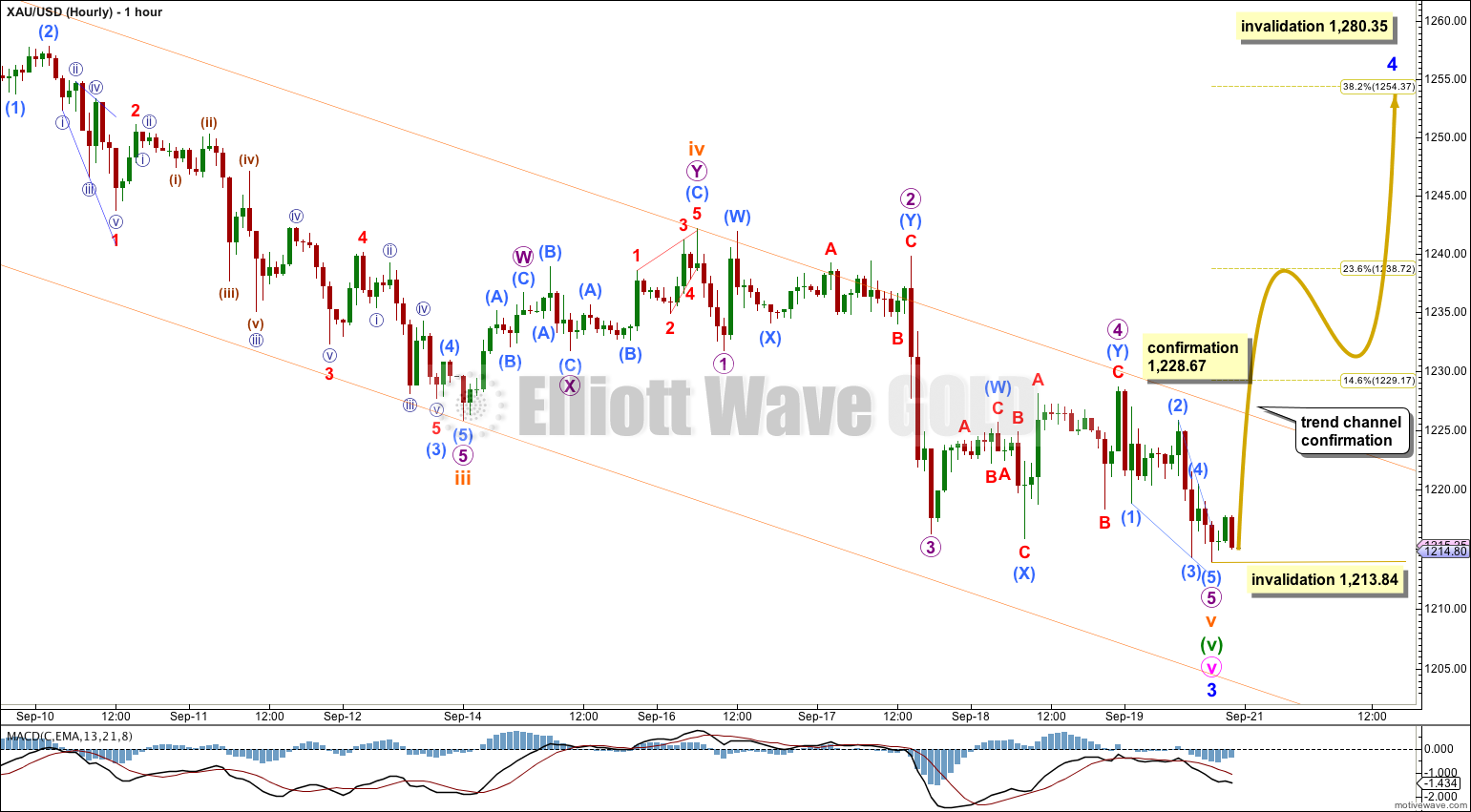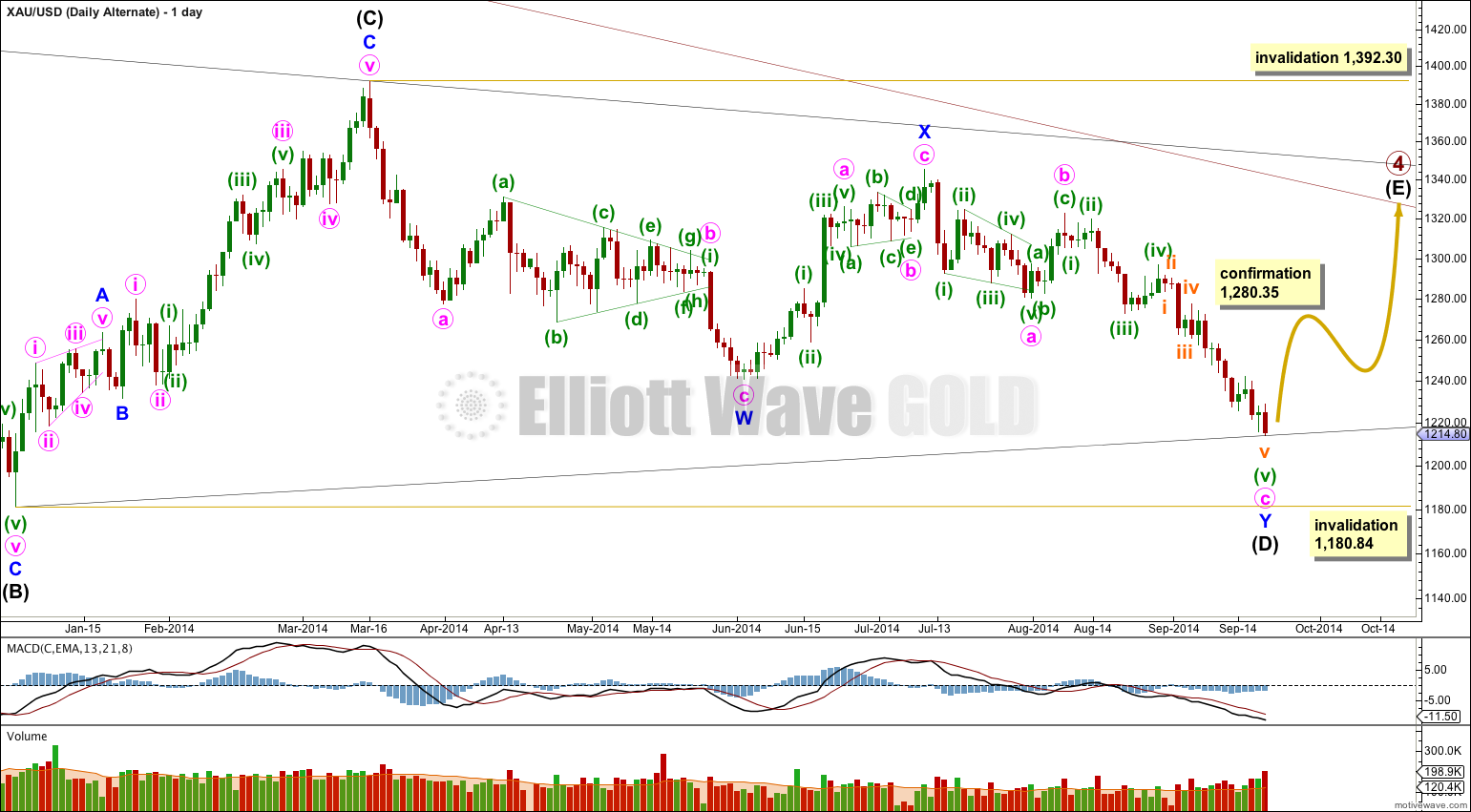Price made a new low and we have another red candlestick which was expected, although price has fallen $2.84 short of the upper edge of the target zone.
Summary: It is most likely that minor wave 3 is over, but this is unconfirmed. Movement above 1,228.67 and above the orange channel on the hourly charts would provide some confirmation that minor wave 3 is over and minor wave 4 is underway. While we do not have confirmation of this trend change we must accept the possibility of more downwards movement on Monday. Once minor wave 4 is confirmed I would expect is most likely to end at the 0.236 or 0.382 Fibonacci ratios, with the 0.382 ratio more likely.
Click on charts to enlarge.
Main Wave Count
Extend the triangle trend lines of primary wave 4 outwards. The point in time at which they cross over may be the point in time at which primary wave 5 ends. This does not always work, but it works often enough to look out for. It is a rough guideline only and not definitive. A trend line placed from the end of primary wave 4 to the target of primary wave 5 at this point in time shows primary wave 5 would take a total 26 weeks to reach that point, and that is what I will expect. Primary wave 4 has ended its 10th week.
The black (B)-(D) trend line is now clearly breached on the daily chart, and also clearly breached on the weekly chart. This is significant.
At 956.97 primary wave 5 would reach equality in length with primary wave 1. Primary wave 3 is $12.54 short of 1.618 the length of primary wave 1, and equality between primary waves 5 and 1 would give a perfect Elliott relationship for this downwards movement.
However, when triangles take their time and move close to the apex of the triangle, as primary wave 4 has (looking at this on a weekly chart is clearer) the movement following the triangle is often shorter and weaker than expected. If the target at 956.97 is wrong it may be too low. In the first instance I expect it is extremely likely that primary wave 5 will move at least below the end of primary wave 3 at 1,180.40 to avoid a truncation. When intermediate waves (1) through to (4) within primary wave 5 are complete I will recalculate the target at intermediate degree because this would have a higher accuracy. I cannot do that yet; I can only calculate it at primary degree.
If minor wave 3 is over here it is 2.84 longer than 1.618 the length of minor wave 1. If it is over here then there are some typically good Fibonacci ratios within it:
Ratios within minor wave 3 are: minute wave iii is 0.98 longer than 2.618 the length of minute wave i, and minute wave v is 5.60 longer than 1.618 the length of minute wave iii.
Ratios within the extended minute wave v are: there is no adequate Fibonacci ratio between minuette waves (i) and (iii), and minuette wave (v) is just 0.33 short of 6.854 the length of minuette wave (i). This is an unusual Fibonacci ratio, but mathematically correct, and this is a very close relationship.
Ratios within the extended minuette wave (v) are: there is no Fibonacci ratio between subminuette waves iii and i, and subminuette wave v is 1.34 short of 0.618 the length of subminuette wave iii.
Movement comfortably below 1,180.84 would invalidate the alternate daily wave count below and provide further confidence in this main wave count.
I have drawn a Fibonacci retracement the length of minor wave 3. Minor wave 4 may correct up to the 0.236 at 1,238.72 (less likely) or 0.382 at 1,254.37 (more likely) Fibonacci ratio, so that there is alternation with the deep correction of minor wave 2. I expect this tendency to alternation may be stronger than a tendency for corrections following fifth wave extensions to reach up to the end of the second wave within the extended fifth wave.
Draw a channel about intermediate wave (1): draw the first trend line from the lows labeled minor waves 1 to 3, then place a copy on the high labeled minor wave 2. Minor wave 4 may find resistance and may end about the upper edge of this blue channel. This indicates minor wave 4 could last only one week / 5 days.
Main Hourly Wave Count.
Micro wave 4 first moved higher after last analysis, remaining within the parallel channel. Micro wave 4 subdivides as a double zigzag, which provides structural alternation with the double combination of micro wave 2. Micro wave 2 is a deep 77% correction, and micro wave 4 is a more shallow 53% correction.
Micro wave 5 subdivides as an ending contracting diagonal. I have checked the subdivisions on a five minute chart and all the subwaves may be seen as zigzags.
Ratios within subminuette wave v are: there is no Fibonacci ratio between micro waves 3 and 1, and micro wave 5 is just 0.26 longer than 0.618 the length of micro wave 3.
There is double divergence at the end of minor wave 3 between price and momentum: strongest downwards momentum is the end of minuette wave (iii) within the extended fifth wave of minute wave v, and closer to the end micro wave 3 has stronger momentum than micro wave 5. This divergence supports the wave count.
Movement above 1,228.67 would invalidate the alternate below and provide price confirmation of this main wave count. Movement above the orange channel would provide trend channel confirmation of this wave count.
Minor wave 4 is highly likely to show structural alternation with minor wave 2. Minor wave 2 was a deep zigzag. Minor wave 4 is most likely to be a flat, triangle or combination. At this early stage there are more than 13 possible corrective structures it may take, and it is impossible to rule out any. Expanded flats, running triangles and combinations may all included new price extremes beyond the start at 1,213.84, and so after the first upwards wave is done we may see a new low as part of minor wave 4. Analysis must be very flexible and I will have alternate wave counts regularly, plus the wave count will change as this correction unfolds. It should last at least one week and most likely be longer, maybe about two weeks, because sideways moving corrective structures are normally more long lasting than brief zigzags.
Alternate Hourly Wave Count.
By simply moving the degree of labeling within the final wave down one degree, this may only be a leading contracting diagonal for the last fifth wave.
If the orange channel is breached this wave count will substantially reduce in probability.
Leading diagonals are not as common as ending diagonals. This reduces the probability of this alternate to less than the main hourly wave count.
The targets remain the same: at 1,211 micro wave 5 would reach 1.618 the length of micro wave 1; at 1,210 subminuette wave v would reach 1.618 the length of subminuette wave i; and at 1,206 minuette wave (v) woudl reach 1.618 the length of minuette wave (iii).
Within micro wave 5 submicro wave (2) may not move beyond the start of submicro wave (1) above 1,228.67.
Draw the orange channel about this last wave down using Elliott’s second technique: draw the first trend line from the highs of subminuette waves ii to iv (I have labeled these clearly now on the daily chart), then place a parallel copy on the low of subminuette wave iii.
Alternate Wave Count
I would judge this wave count to have a very low probability only because of proportion between primary waves 2 and 4. The main wave count sees them almost exactly of the same duration, with primary wave 2 lasting 53 weeks and primary wave 4 lasting 54 weeks. This alternate would see primary wave 4 as much longer in duration than primary wave 2. It is the proportion between second and fourth waves within an impulse which gives the wave count what is called the “right look”. This alternate would still have the right look, but it would not look as good as the main wave count.
If intermediate wave (D) continued further it could only be as a double zigzag. For a contracting triangle intermediate wave (D) may not move beyond the end of intermediate wave (B) below 1,180.84. For a barrier triangle intermediate wave (D) should end about the same level as intermediate wave (B), as long as the (B)-(D) trend line is essentially flat. In practice this means that intermediate wave (D) could end slightly below 1,180.84 and the wave count would remain valid. Unfortunately, this invalidation point is not black and white.
If intermediate wave (D) is a double zigzag, then intermediate wave (C) must be seen as a single zigzag because only one of the five subwaves of a triangle may be a double.
It is possible to see intermediate wave (C) as a zigzag, but to do so a rather obvious triangle must be ignored after the end of minor wave A. The main wave count sees a triangle in that position. I think this reduces the probability of this alternate.
Within intermediate wave (C) the subdivision within minuette wave (i) of minute wave iii of minor wave C is problematic. On the hourly chart this upwards wave subdivides as a double zigzag and does not fit well at all as a five wave structure. This is another reason why I would prefer a wave count which sees a triangle in that position because the subdivisions of those waves fit a triangle perfectly. This further reduces the probability of this alternate.
This alternate wave count does not diverge from the main wave count at this stage, and will not diverge for another one or two weeks. The main wave count expects downwards movement to complete minor wave 3 and this alternate expects downwards movement to complete minute wave c. Thereafter, the main wave count would expect upwards movement for minor wave 4 and this alternate wave count would expect upwards movement for intermediate wave (E). If at that stage price moves above 1,280.35 for that upwards movement then the main wave count would be invalidated and this alternate confirmed.
Intermediate wave (E) of a contracting or barrier triangle may not move beyond the end of intermediate wave (C) at 1,392.30.
This analysis is published about 10:35 p.m. EST.





Hello Lara,
Regarding your main hour count, do you think that minor wave 4 will breach 1243 resistance level which is supposed to be the strong one?
that is entirely possible
my target for it to most likely reach is 1,250.78